|
|
Apartments in Florence, Perugia, Rome, Sorrento and Positano |




|
|
|
|
- You are in: Home » Tuscany » Pisa
VISIT PISA
« All the regions
KNIGHT'S SQUARE
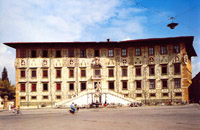
The Knights’ Square (Piazza dei Cavalieri) in Pisa is located at the same place as the forum of the antique Portus Pisanus, as Pisa was called in Roman times. This square was the political centre in medieval Pisa, where the Pisans used to discuss their problems or celebrate their victories. Also on this square, the emissary of Florence proclaimed the end of the independence of Pisa in 1406. The square was rebuilt in renaissance style by Giorgio Vasari, the famous architect of the grand duke Cosimo I de Medici of Florence. He designed the Church of the Cavalieri for the Holy and Military Order of St. Stephan, but it was mainly built by other architects. This is the only church in Pisa in renaissance style. It contains the Turkish banners captured by the Cavalieri of St. Stephan during the naval battle of Lepanto on 7 October 1571. The main building on the square is Palazzo della Carovana, the palace of the Knights of St. Stephan. It was modernised in renaissance style by Giorgio Vasari. The awesome façade is decorated with sgraffiti, equally by Vasari, and contains two niches with busts of grand dukes of Tuscany. It now houses the prestigious Scuola Normale Superiore di Pisa. In front of the palace stands the large statue of Cosimo I de Medici. In the other corner of the square stands the Palazzo dell’ Orologio.
top
MIRACLE'S SQUARE

Pisa is the hometown of Galileo Galilei, the famous physician, who carried out his first experiments on the gravity of the Leaning Tower in Piazza dei Miracoli. In the square, world famous for its leaning bell-tower, one can admire the Baptistery, the Cathedral and the Cemetery, monuments, which are a testimony to the different development phases from the Romanic Style of Pisa to the Gothic. Its internationally known University has its prestigious seat in the 'Scuola Normale di Pisa' located in the historical Cavalieri (Knights) Square.
top
CATHEDRAL SANTA MARIA ASSUNTA
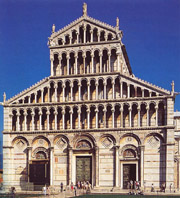
The heart of the Campo dei Miracoli is the Duomo, the medieval cathedral, entitled to St. Mary. It was begun in 1064 by the architect Buscheto and is the originator of the distinctive Pisan Romanesque style in architecture. The mosaics of the interior show a strong Byzantine influence, while the pointed arches point to Muslim influences. The façade, of grey marble and white stone set with discs of coloured marble, was built by a master Rainaldo, as indicated by a write above the middle door: "Rainaldus prudens operator". The massive bronze main doors were made in the workshops of Giambologna. The interior is faced with black and white marble and has a gilded ceiling and a frescoed dome. It was largely redecorated after a fire in 1595, which destroyed most of the medieval art works. The impressive mosaic, in the apse, of Christ in Majesty, flanked by the Blessed Virgin and St. John the Evangelist, which was completed by Cimabue in 1302, survived the fire however. The cupola, at the intersection of the nave and the transept, was decorated by Riminaldi showing the ascension of the Blessed Virgin. The coffer ceiling of the nave was replaced after the fire of 1595. The present gold-decorated ceiling carries the coat of arms of the Medici. The elaborately carved pulpit (1302-1310), which also survived the fire, was the masterpiece of Giovanni Pisano. It shows nine scenes from the New Testament, carved in white marble with a chiaroscuro effect. It contains a bold, naturalistic depiction of a naked Hercules.
top
LEANING TOWER
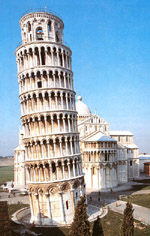
The Tower of Pisa is the bell tower of the Cathedral. Its construction began in the august of 1173 and continued (with two long interruptions) for about two hundred years, in full fidelity to the original project, whose architect is still uncertain. In the past it was widely believed that the inclination of the Tower was part of the project ever since its beginning, but now we know that it is not so. The Tower was designed to be "vertical" and started to incline during its construction. Both because of its inclination, and its beauty, from 1173 up to the present the Tower has been the object of very special attention. During its construction efforts were made to halt the incipient inclination through the use of special construction devices; later colums and other damaged parts were substituted in more than one occasion. Today, interventions are being carried out within the sub-soil in order to significantly reduce the inclination and to make sure that Tower will have a long life. In all this story it is possible to find a meaningful constant, the "genetic code" of the Tower: its continual interaction with the soil on which it was built.
top
BAPTISTERY OF SAINT JOHN
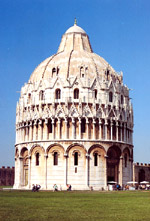
The Baptistery, dedicated to St. John the Baptist, stands opposite the west end of the Duomo. The round Romanesque building was begun in the mid 12th century. It was built in Romanesque style by an architect known as Deotisalvi ("God Save You"). His name is mentioned on a pillar inside, as Diotosalvi magister. It was not, however, finished until the 14th century, when the loggia, the top storey and the dome were added in Gothic style by Nicola and Giovanni Pisano. It is the largest baptistery in Italy. Its circumference measures 107.25 metres. Taking into account the statue of St. John the Baptist (attributed to Turino di Sano) on top of the dome, it is even a few centimetres higher than the Leaning Tower. The portal, facing the facade of the cathedral, is flanked by two classical columns, while the inner jambs are executed in Byzantine style. The lintel is divided in two tiers. The lower one depicts several episodes in the life of St. John the Baptist, while the upper one shows Christ between the Madonna and St John the Baptist, flanked by angels and the evangelists. The immensity of the interior and the acoustics are overwhelming, but it is surprisingly plain and lacks decoration. The pulpit was sculpted between 1255-1260 by Nicola Pisano. The scenes on the pulpit, and especially the classical form of the naked Hercules, show at best Pisano's qualities as the most important precursor of Italian renaissance sculpture.
top
CAMPOSANTO
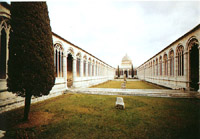
The Camposanto monumentale ("monumental cemetery") lies at the northern edge of the Campo. It is a walled cemetery, which many claim is the most beautiful cemetery in the world. It is said to have been built around a shipload of sacred soil from Golgotha, brought back to Pisa from the 4th Crusade by the archbishop Ubaldo de' Lanfranchi in the 12th century. The building itself dates from a century later and was erected over the earlier burial ground. The building of this huge, oblong Gothic cloister began in 1278 by the architect Giovanni di Simone. The cemetery was only completed in 1464. The outer wall is composed of 43 blind arches and two doorways. Most of the tombs are under the arcades, although a few are on the central lawn. The inner court is surrounded by elaborate round arches with slender mullions and plurilobed tracery. It contained a huge collection of Roman sculptures and sarcophagi, but now there are only 84 left. The walls were once covered in frescoes, the first were applied in 1360, the last about three centuries later. The Stories of the Old Testament by Benozzo Gozzoli (15th century) were situated in the north gallery, wile the south arcade was famous for the Stories of the Genesi by Piero di Puccio (end 15th century). The most remarkable fresco is the realistic The Triumph of Death, the work of an unknown master, called Maestro del Trionfo delle Morte.
top
|
|
|
|
|
|
| TOP DESTINATIONS
|
| Adria Coast, Aeolian Islands, Alessandria, Altopiano Delle Rocche, Amalfi Coast, Aosta, Assisi, Asti, Bari, Brescia, Capo Vaticano, Capri, Catanzaro, Chianti, Cilento, Cinque Terre, Coast Of Marche, Conero Coast, Dolomites, Egadi Islands, Elba, Florence, Garda Lake, Gargano, Ischia, Italian Riviera, Lake Como , Langhe Piedmont, Lecce, Lucca, Lunigiana, Macerata, Mantova, Maremma Tuscany, Monferrato, Montepulciano, Naples, Perugia, Pesaro Urbino, Pisa, Pistoia, Positano, Prato, Procida, Riviera Of Palms, Rome, Salento Coast, Salerno, San Gimignano, Sardinia, Sicily, Siena, Sorrento, Terni, Tiber Valley Of Tuscany, Treviso, Turin, Val Gandino, Veneto, Venice, Viterbo |
|
|










